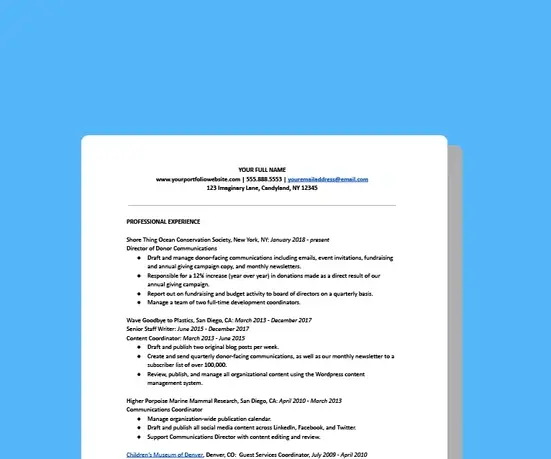How to Fit Your Resume to a Job Listing

When you come across a job opportunity on Idealist that sounds like it could be a fit, it may be tempting to jump straight into the “Qualifications” section of the listing, make a game-time decision, and fire off your standard resume (that you keep handy for just such an occasion).
While there’s often a certain feeling of excitement and urgency when we think we’ve found the one, acting too quickly can be to your detriment. You may even be skipping over important clues that could ultimately help you craft a resume that is better-aligned with the specific role, making you an even stronger candidate.
To ensure you don’t miss any key information—responsibilities, titles, sector-specific lingo—use this checklist to review a job listing. Keep your resume open while you go through the checklist so you can easily compare language and edit or fill in any gaps that may come to light.
What to look for in a job listing
Not every listing uses the same template. Some may clearly label different aspects of the job while others keep it short. Read through the entire job listing and be sure that you can identify the following, even if they’re a bit hidden:
- Organization description and mission
- Job responsibilities
- Candidate requirements vs. “nice to haves”
- Keywords and key lingo
- Application instructions and deadlines
Some overlap in these categories is to be expected. That being said, by pulling out the specific elements included in our list, you can identify a variety of opportunities to demonstrate that you’re a fit.
Organization description and mission
This section of a job description offers a quick snapshot of the organization—size, location, history—as well as their founding mission and vision.
Read about the organization and their mission:
- How does the organization describe their work and community?
- What population do they serve?
- How do they deliver services/programs?
When updating your resume, be sure to include information mined from this section and make appropriate connections that highlight your experience with their target population and/or issue area.
Job responsibilities
This section of the description outlines the types of tasks you will be expected to do on a daily or weekly basis. Compare the responsibilities included to your previous experience and accomplishments:
- Which of your accomplishments most relate to the job functions listed?
- How can you produce similar results at this organization?
- In which areas are you missing experience and how can you supplement?
- Which aspects of the role are you familiar with and excited about?
Matching your current responsibilities and accomplishments to what has been outlined by a hiring organization is critical for crafting an effective resume. Customize your resume to showcase your most relevant experience, skills, and accomplishments.

Free Download
Sign up or log in for access to our free "Perfect Resume" roadmap
Download our exclusive resume resource for a guided tour through best practices, suggested sections, formatting ideas, space savers, and even a few common errors to keep an eye out for.
Qualifications and skills
Job listings will outline the knowledge and experience necessary to do the job. Typically, job seekers are not required to have all the qualifications or skills listed in order to be considered for the position, so don't count yourself out too soon!
Take an inventory of the skills and qualifications listed:
- Identify hard skills (e.g. Quickbooks, language skills, graphic design)
- Take note of soft skills (communication, time management)
- What knowledge or experience is necessary to do the job? Do you have it?
- How did you use these skills in the past, and were there quantifiable results?
- Which skills are you missing, and how might you supplement?
- Determine the transferable skills that you will use to excel at this job.
Pro Tip: If the employer is using an ATS (Applicant Tracking System), you’re likely to find useful keywords in qualifications and skills sections (more on that below!).
There are several ways to demonstrate your understanding or mastery of a skill or qualification using your resume (rather than including all of those highlights in your cover letter). For example, if you hold a required degree listed by the hiring organization, feature it in your education section. If the description includes proficiency in a language or tech know-how, you might add “Bilingual English/Spanish” or “HTML” to your skills section.
Keep in mind that some skills—like project management or communications—broadly fall under the category of "transferable skills." This means that there are many things you may have done in a previous role that can relate to and strengthen these skills.
Candidate attributes and characteristics
Attributes and characteristics can help you to better envision how you may add to and enhance the organization’s culture (we’re not talking about culture fit, here!). These will likely be listed through a description rather than in one specific section. For example: ambitious, achievement-oriented, cooperative, enthusiastic, diplomatic, and assertive.
Read through the entire job listing:
- What are the attributes and characteristics listed in the description?
- Which ones best describe you? Think about examples from your work history that depict you as having those attributes and characteristics.
- Take note of the attributes listed and what they say about the culture and organization’s needs.
By including attributes and characteristics from the job description on your application, you can demonstrate that you’re a match and that you are aware of what makes their organization tick!
Keywords and key lingo
Keywords are those which show up in the job description repeatedly. The term “keyword” can also refer to hard skills (such as Quickbooks or proficiency in a language). Key “lingo” refers to the words the organization uses to create a more complete picture of it’s culture and atmosphere.
Familiarize yourself with the keywords used throughout the description:
- Focus on the words that show up repeatedly
- Note the hard skills listed as these also tend to be part of the organization’s “keywords” list
- When applicable and organic, use the language from the job description in your resume
Identify how you can be a culture add by locating the “lingo” in the listing:
- Pay attention to the language and tone to get a sense of the organization’s culture and values
- Ask yourself, “Is this a good fit for me?”
Key lingo is another strategic add to your resume—it might be as simple as using “organization” instead of “company." When you use the same lingo as the hiring organization, you’re offering strong evidence that you have an eye for detail and an understanding of the sector, field, or issue area.
Application instructions and deadlines
Read through this section to familiarize yourself with the application documents you will need and take note of any deadlines.
After paying such close attention to other clues of the job description, it may be easy to overlook this small yet critical part of the application process. You’ll want to be sure to keep the following in mind:
- Submit all required documents on (or preferably, before) the deadline date if one is mentioned.
- Do they ask for everything submitted through the Idealist ATS? Submit everything through the Idealist ATS! Do they ask for all documents to be sent as a single PDF? Send all documents as a single PDF!
By carefully adhering to the suggestions in this checklist, upon submission, your application will be more polished, relevant, and eye-catching to the hiring manager.
As the Associate Director of Marketing and Communications at Idealist and a lifelong nonprofit professional, Alexis offers job seekers, game changers, and do gooders actionable tips, career resources, and social-impact advice.






